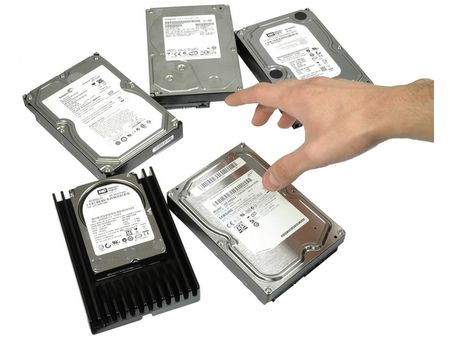Tom’s Winter 2008 Hard Drive Guide
Buying The Perfect Hard Drive
Despite the availability of huge capacities and incredible price drops in the hard drive segment, finding the perfect hard drive is not as easy as pegging the right size for your precious information. It used to be that choosing a good hard drive meant finding one that delivered great performance at a reasonable cost per gigabyte. Today, you’ll have to choose among performance drives, mainstream models, and low-power drives—and the high-end will gradually be taken over by solid state drives (SSDs) based on flash memory chips instead of rotating magnetic media. Which drive should you buy today?
New Market Segments = More Choices
A few years ago, you could differentiate hard drives simply by their market segments: there were desktop, laptop, and professional hard drives for servers and workstations. Desktop and server drives typically were based on the 3.5” form factor, while laptop drives were smaller (2.5”). Professional drives utilized SCSI, while all other drives were connected with some sort of ATA interface. That was all you needed to know to find an appropriate hard drive.
Today, the traditional market segments are divided into additional sections, typically by the intended application. Desktop hard drives are now divided into performance drives, high capacity and mainstream models, or high efficiency drives. The professional segment is split into high capacity, high efficiency, and high performance server/workstation drives. The mobile PC market has performance drives, mainstream, and high-capacity drives for notebooks and laptops.
As a consequence, classifying a drive by its interface, the storage technology it uses or its form factor doesn’t work anymore. For example, 2.5” drives have entered the server/workstation market as well as the desktop. Cheap Serial ATA interfaces are utilized for entry-level professional drives, while 10,000 RPM drives are available for desktops and flash-based SSDs are gradually attacking the hard drive market from the high-end and the very low-end.
Flash To Take Over?
Properly-designed flash-based solid state drives are not only faster than conventional drives, they can also require considerably less power—combine these and you get stellar performance per watt results. Flash SSDs are robust and deliver data without significant access time delay, and the latest product generation delivers 200 MB/s of throughput—and this is just the beginning. Specialized flash SSD makers, such as Mtron and Memoright, design products aimed at the server market, where a maximum number of I/O operations per second is essential. In fact, a few professional flash SSDs are easily capable of beating any array of conventional drives today. At the same time, the desktop market is being attacked by multiple storage vendors, including heavyweights such as Samsung and even Intel, with its X25-M flash SSD.
Get Tom's Hardware's best news and in-depth reviews, straight to your inbox.
However, flash is not (yet) the holy grail. It is still many times more expensive than traditional hard drives at mainstream capacities and it cannot yet answer high capacity demands. Even if flash memory were cheaper and ready for mainstream capacities (250-750 GB) there still wouldn’t be sufficient supply of chips. A high end flash SSD is indeed the best choice if you’re looking for a fast system drive, but capacities are still limited to 128 or 160 GB, and the substantial investment required will depreciate horribly quickly. If you’re willing to spend as much money on a flash SSDs as most people spend on an entire PC, or should the performance advantage provide your company with a competitive advantage, then we recommend reading our last flash SSD roundup.
HDDs Remain Unrivaled In The Mainstream
Given the current limitations of flash-based drives, conventional hard drives will remain the dominant storage media for PC systems for at least another few years. In this light, it appears important to make the right choice, as a drive with a capacity of one terabyte (1,000 GB) will certainly last you for a few years, even if you have to buy a second or third disk in that span. We looked at high capacity hard drives from Hitachi, Samsung, Seagate, and Western Digital, and compared them with some 24/7 drives and a few low power models. We added in WD’s Velociraptor drive, which is still the fastest desktop hard drive on the market.
Current page: Buying The Perfect Hard Drive
Next Page Desktop HDDs: Differences